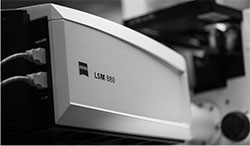James Trimmer, Ph.D.

Distinguished Professor Emeritus
4206 Tupper Hall
Davis Campus
530-754-6075
jtrimmer@health.ucdavis.edu
Lab Website
Research Interests
As neuroscience enters the post-genomic era, a major goal is the translation of genomic sequence information into a molecular understanding of the mechanisms of neuronal information processing and transfer. My laboratory’s research focuses on protein function, biochemical pathways and networks of protein-protein interactions regulating intra- and inter-cellular signaling in mammalian neurons. In particular, we are interested in dynamic regulation of voltage-sensitive ion channel abundance, localization and function through reversible protein phosphorylation. These proteins determine the intrinsic electrical properties of neurons and how these cells respond to external stimuli, integrate the encoded information and generate an appropriate response. Modern proteomic techniques have allowed for insights into protein networks, and post-translational modifications, that provide for both the generation and maintenance of complex cellular functions, but also their dynamic regulation that underlies functional plasticity. Our studies are aimed at a molecular understanding of how neuronal ion channels generate and maintain the fidelity of neuronal signaling, and how these processes can be dynamically regulated to generate neuronal plasticity. Such information is necessary for an increased understanding of not only the normal functional plasticity of neurons, but also in understanding of disease states where neuronal function is altered and effects of acute external insults such as ischemia and drugs of abuse, and represent a key step towards the development of therapeutics that can address these and other psychiatric and neurological disorders. Moreover, these studies are representative of approaches that would prove advantageous to studies on other neuronal signaling proteins. To better translate findings from genome-based studies, we have also established the UC Davis/NIH NeuroMab facility, to use information on proteins encoded in the human and other genomes to generate monoclonal antibodies for use in the research community.
Graduate Group Affiliations
An updated list of current publications: PubMed
Rego, M., Houston, D. W., Fan, M., Murray, K. D. and J. S. Trimmer. "Open-source Antibodies as a Path to Enhanced Research Reproducibility and Transparency". New Biotech. 87:121-129. PMID: 40252918.
Mitchell, K. G., Hunter, S. S., Froenicke, L., Murray, K. D., Settles, M. L., and J. S. Trimmer. "clonevdjseq: A Workflow and Bioinformatics Management System for Sequencing, Archiving, and Analysis of VDJ Sequences from Clonal Libraries". BMC Bioinformatics (in press).
Ferns, M., van der List, D., Vierra, N. C., Lacey, T., Murray, K. D., Kirmiz, M., Stewart, R. G., Sack, J. T., and J. S. Trimmer. "The Electrically Silent Kv5.1 Subunit Forms Heteromeric Kv2 Channels in Cortical Neurons and Confers Distinct Functional Properties". J. Neurosci. 45:e2293232025. PMID: 39933932.
Kahn, R. A., Virk, H., Laflamme, C., Houston, D. W., Polinski, N. K., Meijers, R., Levey, A. I., Saper, C. B., Errington, T. M., Turn, R. E., Bandrowski, A., Trimmer, J. S., Rego, M., Freedman, L. P., Ferrara, F., Bradbury, A. R. M., Cable, H., and S. Longworth. (2024). "Antibody Characterization is Critical to Enhance Reproducibility in Biomedical Research". eLife 13:e100211. PMID: 39140332.
Han, X., Lu, X., Li, P.H., Wang, S., Schalek, R., Meirovitch, Y., Lin, Z., Adhinarta, J., Murray, K. D., MacNiven, L. M., Berger, D., Wu, Y., Fang, T., Meral, E. S. Asraf, S., Ploegh, H., Pfister, H., Wei, D., Jain, V., Trimmer, J. S. and J. W. Lichtman. (2024). "Multiplexed Volumetric CLEM Enabled by scFvs Provides Insights into the Cytology of Cerebellar Cortex". Nat. Commun. 15:6648. PMID: 39103318.
Micheva, K. D., Gong, B., Collman, F., Weinberg, R. J., Smith, S. J., Trimmer, J. S., and K. D. Murray. “Developing a Toolbox of Antibodies Validated for Array Tomography-Based Imaging of Brain Synapses”. eNeuro 10(12):ENEURO.0290-23.2023. PMID: 37945352.
Matsumoto, C. T., O’Dwyer, S. C., Manning. D. C., Hernandez-Hernandez, G., Rhana, P., Fong, Z., Sato, D., Clancy, C. E., Vierra, N. C., Trimmer, J. S., and L. F. Santana. (2023). “The Formation of Kv2.1 Macro-Clusters is Required for Sex-Specific Differences in L-type Cav1.2 Clustering and Function in Arterial Myocytes”. Commun. Biol. 6:1165. PMID: 37963972.
Mitchell, K. G., Gong, B., Hunter, S. S., Burkart-Waco, D., Gavira-O’Neill, C. E., Bzymek, M., Goethel, M. E., Templeton, K. M., MacNiven, L. M., Murray, K. D., Settles, M. L., Froenicke, L., and J. S. Trimmer. (2023). “High‑Volume Hybridoma Sequencing on the NeuroMabSeq Platform Enables Efficient Generation of Recombinant Monoclonal Antibodies and ScFvs for Neuroscience Research”. Sci. Rep. 13:16200. PMID: 37758930.
Vierra, N. C., Ribeiro-Silva, L., Kirmiz, M., van der List, D., Bhandari, P., Mack, O. A., Carroll, J., Le Monnier, E., Aicher, S. A., Shigemoto, R., and J. S. Trimmer. (2023). “ER-PM Junctions Function to Couple Excitation to Ca2+-Activated PKA Signaling”. Nat. Commun. 14:5231. PMID: 37633939.
Casas, M., Murray, K. D., Hino, K., Vierra, N. C., Simó, S., Trimmer, J. S., Dixon, R. E., and E. J. Dickson. (2023). “NPC1-Dependent Alterations in Kv2.1–Cav1 Nanodomains Drive Neurodegeneration”. Nat. Commun. 14:4553. PMID: 37507375.
Dixon, R. E., and J. S. Trimmer. (2023). “ER-PM Junctions as Sites of Depolarization-Induced Ca2+ Signaling in Excitable Cells”. Annu. Rev. Physiol. 85: 217-243. PMID: 36202100.
Trimmer, J. S. (2022). “Genetically Encoded Intrabodies as High-Precision Tools to Visualize and Manipulate Neuronal Function”. Sem. Cell Dev. Biol. 126: 117-124. PMID: 34782184.
Colecraft, H. M., and J. S. Trimmer. (2022). “Controlling Ion Channel Function with Renewable Recombinant Antibodies”. J Physiol. 600: 2023-2036. PMID: 35238051.
Vierra, N. C., and J. S. Trimmer. (2022). “Ion Channel Partnerships: Odd and Not-So-Odd Couples Controlling Neuronal Ion Channel Function”. Int. J. Mol. Sci. 23: 1953. PMID: 35216068.
Vierra, N. C., O’Dwyer, S. C., Matsumoto, C., Santana, L. F., and J. S. Trimmer. (2021). “Regulation of Neuronal Excitation-Transcription Coupling by Kv2.1-induced Clustering of Somatic L-type Ca2+ Channels at ER-PM Junctions”. Proc. Nat. Acad. Sci. USA 118 (46):e2110094118. PMID: 34750263.
Fortenbach, C., Allina, G. P., Shores, C. M., Karlen, S. J., Miller, E. B., Bishop, H. I., Trimmer, J. S., Burns, M. E., and E. N. Pugh, Jr. (2021). “Loss of the K+ Channel Kv2.1 Greatly Reduces Outward Dark Current and Causes Ionic Dysregulation and Degeneration in Rod Photoreceptors”. J. Gen. Physiol. 153:e202012687. PMID: 33502442.
Hawkins, N. A., Misra, S. N., Jurado, M., Kang, S. K., Vierra, N. C., Nguyen, K., Wren, L., George Jr., A. L., Trimmer, J. S., and J. A. Kearney. (2021). “Epilepsy and Neurobehavioral Abnormalities in Mice with a Dominant-Negative KCNB1 Pathogenic Variant”. Neurobiol. Dis. 147:105141. PMID: 33132203.
- NPB 107, Cell Signaling in Health and Disease
- NPB 110A Foundations: From Molecules to Individuals
- Established Investigatorship, American Heart Association
- National Institute of Neurological Disorders and Stroke, National Institutes of Health, Jacob Javits Neuroscience Investigator (MERIT) Award
- UC Davis Graduate Student Association Award for Excellence in Service to Graduate Students




 Make a donation using our secure online system.
Make a donation using our secure online system.